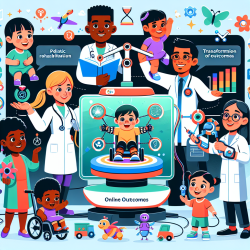Introduction
In the quest to improve children's health outcomes, especially in rural areas, telemedicine has emerged as a promising tool. A recent study titled Mobile Health School Screening and Telemedicine Referral to Improve Access to Specialty Care in Rural Alaska: Integrating Mixed Methods Data to Contextualize Trial Outcomes explores how telemedicine can be used effectively in school hearing screenings. This blog aims to help practitioners enhance their skills by implementing the outcomes of this research or by encouraging further investigation.
The Study: A Closer Look
The study conducted in 15 rural Alaskan communities used a cluster-randomized controlled trial to compare a telemedicine specialty referral pathway with a standard primary care referral pathway for school hearing screenings. The results were compelling: children in telemedicine referral communities were 2.3 times more likely to receive follow-up care than those in primary care referral communities.
Key Findings and Factors for Success
Through a mixed-methods approach, the study identified several factors that contributed to the success of the telemedicine intervention:
- Clinic Capacity: Adequate staffing and manageable patient loads were crucial for successful follow-up.
- Personnel Ownership and Engagement: Staff investment and clear ownership of processes were pivotal.
- Communication: Consistent and clear communication between schools, clinics, and families facilitated better outcomes.
- Awareness: Understanding the importance of follow-up among all stakeholders was essential.
Implications for Practitioners
For practitioners, these findings offer actionable insights. Here are some steps you can take to improve outcomes in your own practice:
- Ensure adequate staffing and efficient workflows to manage patient loads effectively.
- Foster a sense of ownership among staff for the telemedicine referral process.
- Establish open communication channels between all stakeholders, including schools, clinics, and families.
- Educate parents and caregivers about the importance of follow-up care after hearing screenings.
Encouraging Further Research
The variability in outcomes between communities suggests that further research is needed to understand the contextual factors that influence the success of telemedicine interventions. Practitioners are encouraged to explore these factors in their own settings and contribute to the growing body of knowledge on this topic.
Conclusion
Telemedicine has the potential to revolutionize access to specialty care, especially in rural areas. By focusing on key factors such as clinic capacity, personnel engagement, communication, and awareness, practitioners can significantly improve follow-up rates and overall outcomes for children. As we continue to explore and refine these interventions, the future of school hearing screenings looks promising.
To read the original research paper, please follow this link: Mobile Health School Screening and Telemedicine Referral to Improve Access to Specialty Care in Rural Alaska: Integrating Mixed Methods Data to Contextualize Trial Outcomes.










